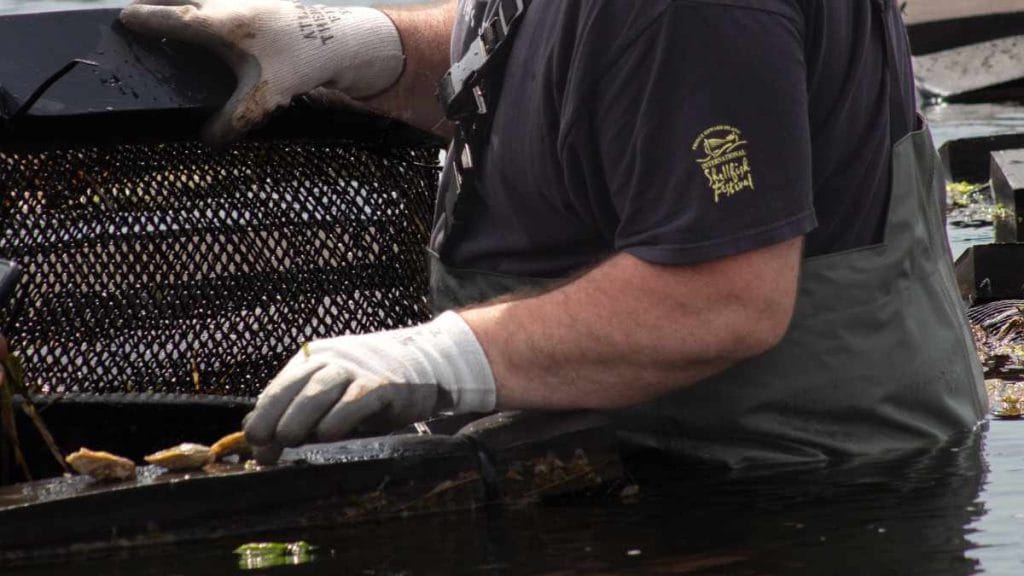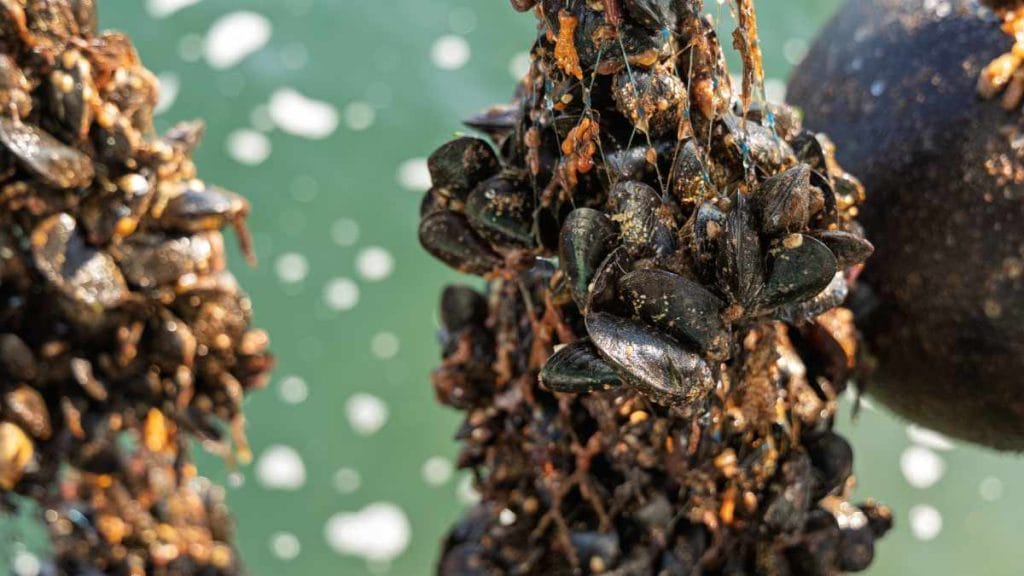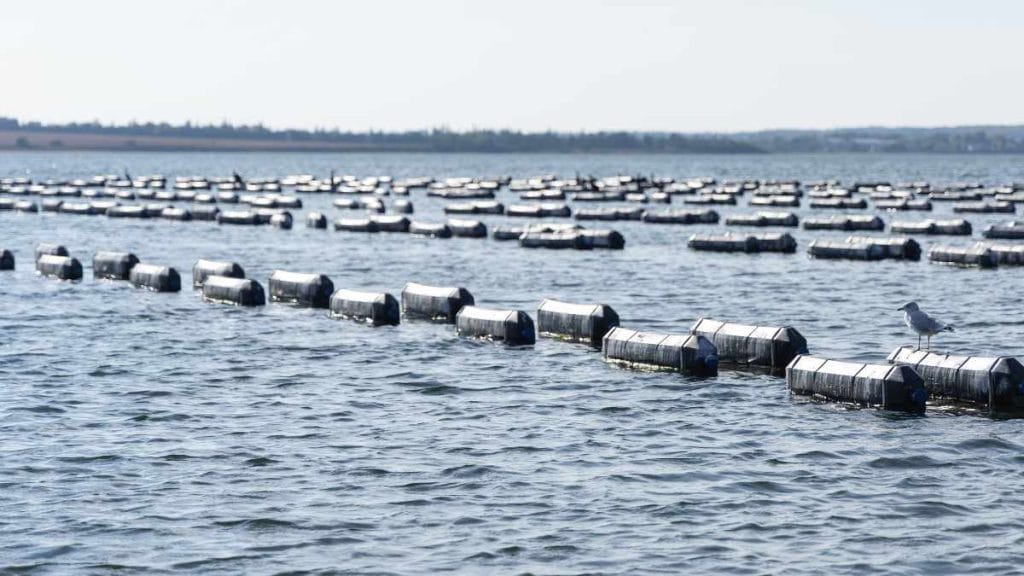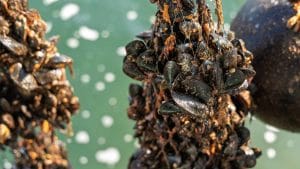Like a fish out of water
When I stepped onto an oyster barge in Prince Edward Island for the first time, I felt like a fish out of water. The ropes, the tides, the cages bobbing in the bay were a far cry from the grain bins and barns I grew up with on the Prairies. But the more I observed, the more I saw something familiar: the passion and pride of people working with nature to feed others.
In case you’re not aware, mussels are bivalve mollusks, similar to oysters and clams. The PEI mussels I saw that are supplied to stores and restaurants in Canada are from the ‘mytilus edulis’ species, which grows all along the Atlantic coastline from Virginia to the Arctic.
If you’ve ever wondered how oysters or mussels are farmed, here are some of the questions PEI farmers answered as I got my first salty taste of shellfish farming while on tour with Canada’s Food Island.

Photo: Source: Brody Trainor, Canada’s Food Island
1. How are mussels and oysters farmed in PEI?
In Prince Edward Island, mussels and oysters are farmed using aquaculture leases in bays and estuaries. Mussels are grown on suspended ropes where they feed and grow naturally. Oysters are farmed using either bottom culture (on the seabed) or off-bottom methods (in floating mesh bags or cages).

Photo: Source: Brody Trainor, Canada’s Food Island
It all starts with baby oysters and mussels. During spawning season, oysters and mussels release eggs and sperm into the water, where fertilization happens externally. The resulting larvae drift freely for several weeks. Shellfish farmers place ropes, mesh collectors, or shells into the water to collect these larvae. When the larvae settle and attach, they become spat which are transferred to grow-out areas where farmers tend them until they reach harvest size.
2. Are PEI mussels and oysters ever harvested from the wild ocean bottom?
Mussels in PEI are always farmed. There is no commercial wild harvest of mussels in PEI. Farmed mussels offer better quality, consistent yield and less environmental impact compared to commercial harvesting of wild seabeds.

Photo: Source: Brody Trainor, Canada’s Food Island
A small number of wild oysters, such as Mapleque Oysters, are still harvested using traditional wooden tongs by licensed fishers on public beds. These oysters grow naturally on the seabed and take 5 to 7 years to mature. Tonged oysters are rare, but if you do get them, expect them to be denser, meatier, and brinier with the distinct taste of the sea.
3. Do mussels and oysters need to be fed?
No. Mussels and oysters are filter feeders, which means they feed on plankton and nutrients naturally found in the water. That means as they feed, they also help clean and clarify coastal waters, making mussel and oyster farming one of the most sustainable seafood choices.
4. Are growth hormones or medications ever used in shellfish farming?
No, there are no growth hormones, antibiotics, medications or chemical treatments used in shellfish farming. The shellfish grow at their natural rate, depending on water temperature, food availability, and growing method.
Shellfish health depends directly on clean water, so farmers closely monitor environmental conditions and work hard to keep their growing areas as pristine as possible.

Photo: Source: Brody Trainor, Canada’s Food Island
5. How long does it take to grow mussels and oysters to harvest size?
Mussels typically take 12 to 24 months to reach market size. Top culture oysters take 3 to 4 years, while bottom culture oysters grown on the seabed take 5 to 7 years to mature.

Photo: Source: Brody Trainor, Canada’s Food Island
6. Does shellfish waste have an environmental impact?
Mussel and oyster “waste” consists mostly of tiny organic particles that settle to the seafloor, where it becomes food for other marine life. In healthy, well-flushed bays, this natural process helps cycle nutrients rather than contribute excess waste.
And the empty shells? They’re far from waste. Shells are rich in calcium carbonate and often recycled into new uses. Some go back into the water to provide habitat for baby shellfish, while others are crushed for soil improvement, livestock feed, landscaping, or even road material. Recycling shells helps close the loop and supports the sustainability of shellfish farming.
Shellfish aquaculture in PEI is monitored by both provincial and federal agencies.
7. How are mussels and oysters stored, shipped and kept fresh?
After harvest, shellfish are washed, sorted, and chilled. Once packed, mussels and oysters are packed in breathable mesh bags or boxes with ice or damp seaweed to keep them cool and moist. When handled properly, live mussels keep for 7 to 10 days and oysters up to two weeks. Both are shipped across Canada and around the world with PEI supplying 80% of North America’s mussels and 30% of Canada’s oysters.
To ensure a fresh supply of mussels and oysters throughout the year, oysters and mussels are held in the water, even during winter when they are under several feet of ice. It makes for an icy, challenging retrieval by the farmers, but ensures a steady supply.

Photo: Source: Brody Trainor, Canada’s Food Island
With those questions answered, there’s only one thing left to do: taste the difference that PEI’s coastal waters and its passionate shellfish farmers make.
Other articles you may be interested in:




